Select Your Region
IMPROVE SKIN HEALTH WITH ASTAREAL®
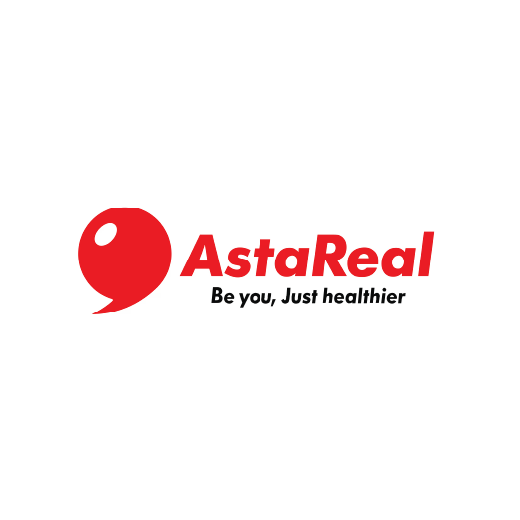
HOW ASTAREAL® ASTAXANTHIN WORKS IN SKIN
Natural astaxanthin acts on all skin layers to reduce visible signs of aging by supporting skin hydration, elasticity, and smoothness. Some antioxidants cannot reach skin cells because they are blocked by the cell membrane.
Astaxanthin is a fat-soluble nutrient with a unique structure that is a perfect match for skin’s cell membranes. Astaxanthin protects what other antioxidants cannot. Natural astaxanthin can be used topically or taken orally to help maintain healthy skin. Natural astaxanthin helps skin lock in moisture, makes skin more resilient to environmental factors, promotes the longevity of existing dermal structures, and supports the skin’s ability to replenish important components that contribute to the maintenance of hydrated, smooth, elastic, and younger-looking skin.
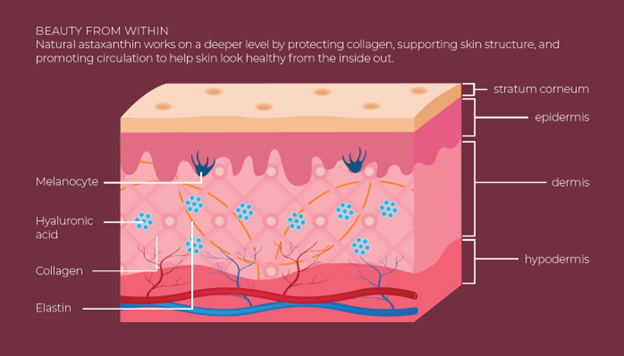
HOW ASTAREAL® ASTAXANTHIN WORKS FOR SKIN HYDRATION
HYDRATION
The topmost layer of skin is called the stratum corneum (SC), and it is in charge of locking in moisture. Because this skin layer is directly exposed to the environment, it is sensitive to UV, pollution, low humidity, and cigarette smoke, all of which can induce inflammation and trigger reactive oxygen species (ROS) accumulation that can compromise the integrity of the SC. A weakened SC means more water loss from skin due to evaporation, causing dry skin.
Underneath the SC are the skin’s epidermal and dermal layers, both of which contain an abundance of hyaluronic acid (HA). While HA is present in numerous tissues, including in joints and in the eye, 50% of the body’s HA is found in skin, where it works to keep skin plump and hydrated by binding 1,000 times its weight in water.
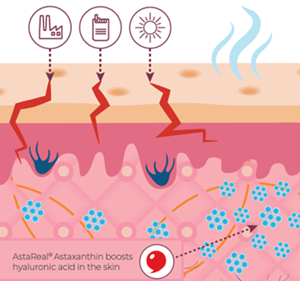
HA molecules in skin turn over approximately once a day, making way for newly made HA molecules. However, we lose our ability to regenerate HA in the epidermis as we age, contributing to sagging skin that is more prone to dryness. Astaxanthin and other carotenoids have been shown to boost the skin’s ability to produce HA, suggesting a way to combat the loss of HA in aging skin.
*These are suggested structure and function claims based on AstaReal® studies. These suggested structure and function claims have not been verified for promotional use by a regulatory team. We encourage you to review the studies with your regulatory affairs team to confirm their suitability for promotional applications.
Clinical studies with AstaReal® astaxanthin support the following suggested structure and function claims for skin:
- In Tominaga et al. 2009, 30 healthy women (ages 20–55) who supplemented with 6 mg per day AstaReal® astaxanthin taken orally, and 0.94 mg per day AstaReal® astaxanthin applied topically for eight weeks showed improvement in the size of SC cells called corneocytes (p<0.01). Corneocytes showing pileups indicate the presence of older, damaged cells. The AstaReal® group showed fewer corneocyte pileups, suggesting that AstaReal® astaxanthin supported a healthy SC able to retain skin moisture better.
- Yamashita et al. 2002 published a double-blind, placebo-controlled study wherein the effect of AstaReal® astaxanthin on skin water content (microsiemens) was examined in 16 healthy women (mean age 40) with dry skin. The AstaReal® group (n=8) experienced an improvement in skin hydration 17 times greater than that observed in the placebo group (n=8) after supplementing with 2 mg per day AstaReal® for four weeks (p<0.05).
- Tsukahara et al. 2016 showed similar results in a double-blind, placebo-controlled trial including 20 healthy women (ages 30–49). The AstaReal® group (n=10), after taking 3 mg per day AstaReal® in a drink formulation for eight weeks, had significantly more hydrated skin than the control group (n=10; water content in Corneometer units, p<0.01; transepidermal water loss, p<0.05). The AstaReal® group had a 3% increase in water content and a 5% decrease in the rate of water loss after eight weeks compared to baseline. The control group had an 11% decrease in water content and a 20% increase in the rate of water loss after eight weeks compared to baseline.
*These are suggested structure and function claims based on AstaReal® studies. These suggested structure and function claims have not been verified for promotional use by a regulatory team. We encourage you to review the studies with your regulatory affairs team to confirm their suitability for promotional applications.
HOW ASTAREAL® ASTAXANTHIN WORKS FOR ELASTICITY
ELASTICITY
The dermis is home to cells called fibroblasts, which produce the skin’s structural proteins, including elastin. A network of elastin fibers in the dermis contributes to the skin’s elasticity, allowing skin to stretch when we smile and resume its original shape afterward.
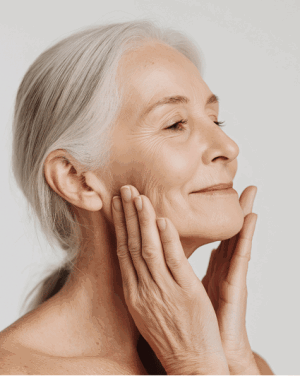
Elastin fibers are unusually long-lived proteins found in skin, blood vessels, and other tissues. They are formed during development in utero and must last through a lifetime of mechanical and biochemical stress—including oxidative stress induced by ROS. For example, elastin in the aorta must maintain the ability to mechanically recoil 3 × 109 times over the course of a 70-year lifespan.
Elastin proteins accumulate damage with age, and there are currently no approved cosmetic products that enhance elastin production. So, it is important to protect existing elastin fibers from environmental stressors. AstaReal® astaxanthin neutralizes free radicals produced by exposure to environmental stressors that contribute to cumulative damage of elastin fibers in skin. AstaReal® astaxanthin has been shown in clinical studies to support skin elasticity.
*These are suggested structure and function claims based on AstaReal® studies. These suggested structure and function claims have not been verified for promotional use by a regulatory team. We encourage you to review the studies with your regulatory affairs team to confirm their suitability for promotional applications.
Clinical studies with AstaReal® astaxanthin support the following suggested structure and function claims for skin:
- In Tominaga et al. 2009, 30 healthy women (ages 20–55) who supplemented with 6 mg per day AstaReal® astaxanthin taken orally, and 0.94 mg per day AstaReal® astaxanthin applied topically for eight weeks experienced a 3.3% improvement in skin elasticity after supplementation compared to the baseline (p<0.01).
- In Seki et al. 2001, 11 healthy women (ages 21–40) applied AstaReal® astaxanthin topically. After three weeks, seven (64%) participants reported feeling smoother skin with better elasticity. Visual inspection and palpation showed improved skin elasticity in subjects of all skin types (normal, dry, and combination skin).
- Tsukahara et al. 2016 used AstaReal® astaxanthin in a drink formulation to examine its effect on skin elasticity in 20 healthy women (ages 30–49). In this double-blind, placebo-controlled study, participants who had ingested 3 mg per day AstaReal® (n=10) in the form of a drink for eight weeks experienced an 18% improvement in viscoelasticity compared to only 2% improvement in the control group (n=10; p<0.05).
- Tominaga et al. 2012 was a double-blind, placebo-controlled trial with 36 healthy men (ages 20–60) supplementing with 6 mg per day AstaReal® and 0.94 mg per day AstaReal® topical application (n=18) or placebo (n=18) capsules for six weeks. The AstaReal® group experienced a significantly greater improvement in skin elasticity after six weeks than the control group (p<0.05).
*These are suggested structure and function claims based on AstaReal® studies. These suggested structure and function claims have not been verified for promotional use by a regulatory team. We encourage you to review the studies with your regulatory affairs team to confirm their suitability for promotional applications.
HOW ASTAREAL® ASTAXANTHIN WORKS FOR SKIN SMOOTHNESS
SMOOTHNESS
The collagen protein network in the dermis is responsible for the skin’s tensile strength and smoothness. Unlike skin cells in the epidermis that turn over every 28 days, collagen protein in the skin’s dermis is produced by fibroblasts and has a half-life of 15 years. Studies using human fibroblasts show how sensitive collagen production is to oxidative stress, obliterating collagen production in fibroblasts exposed to superoxide radicals. However, when fibroblasts were pretreated with AstaReal® astaxanthin prior to exposure to free radicals, 80% of the cells’ collagen production capacity was spared.
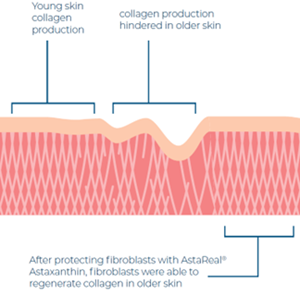
This suggests that AstaReal® astaxanthin can protect fibroblasts from free radical damage and preserve the ability to regenerate collagen. Clinical studies have shown that supplementation with AstaReal® astaxanthin improved skin texture and reduced fine lines for smoother skin.
- Protects the skin’s collagen layer
- Reduces the size of fine lines and wrinkles
- Improves skin texture
- Promotes smooth skin
- Protects skin condition from seasonal stress (low humidity)
Clinical studies with AstaReal® astaxanthin support the following suggested structure and function claims for skin:
- Tominaga et al. 2009 reported on the effects of AstaReal® astaxanthin on skin smoothness in an open-label clinical study of 30 healthy female subjects (ages 20–55). Skin topography of the subjects’ cheeks was determined using image analysis before and after the study, examining the regularity of skin texture as an indicator of smoothness and a healthy dermal protein network. Participants supplemented with 6 mg per day AstaReal® astaxanthin taken orally, and 0.94 mg per day AstaReal® astaxanthin topical application for four weeks. Following supplementation, the analysis of cheek smoothness showed a 4% improvement compared to the baseline (mean depth of roughness, μm; n=30; p<0.01).
- Tsukahara et al. 2016 also examined the effects of AstaReal® astaxanthin on skin smoothness in 20 healthy women (ages 30–49) in a double-blind, placebo-controlled trial. Image analysis was used to measure variations on the skin surface before and after the trial. Participants who ingested 3 mg per day AstaReal® (n=10) in the form of a drink for eight weeks had significantly smoother skin than the control group (n=10, p<0.01) and showed a 16% improvement in smoothness after eight weeks, while the control group had a 33% increase in roughness compared to the baseline.
- Tominaga et al. 2009 reported an in vitro study examining collagen production by skin fibroblasts exposed to ROS. The study showed that vitamin C, known for its ability to boost collagen production, was not able to protect skin fibroblasts from damage upon exposure to ROS. Therefore, cells treated with vitamin C prior to ROS exposure lost all collagen production ability.
In contrast, skin fibroblasts incubated with AstaReal® astaxanthin were able to neutralize enough ROS to improve fibroblast survival and protect 80% of collagen production. When AstaReal® astaxanthin and vitamin C were combined, the cells were able to survive ROS exposure owing to the action of AstaReal® astaxanthin, which allowed vitamin C to exert its collagen-boosting activity. Skin fibroblasts incubated with both AstaReal® astaxanthin and vitamin C produced 108% more collagen than cells that were never exposed to ROS in the first place.
This suggests that AstaReal® astaxanthin works to protect skin cells from oxidative stress, which helps both preserve existing collagen and the ability to produce new collagen. AstaReal® astaxanthin can act in synergy with collagen-boosting ingredients, like vitamin C, making it an essential component for effective skin health formulations.

HOW ASTAREAL® ASTAXANTHIN WORKS FOR AGE SPOTS
AGE SPOTS
Age spots are tan to dark-brown-colored spots commonly appearing with age in sun-exposed areas of skin, such as the face and hands. Age spots may appear after prolonged exposure to UV-induced inflammation and photooxidation associated with a buildup of melanin (solar lentigines) or lipofuscin (senile lentigines).
Studies suggest that solar lentigines are produced when UV-exposed keratinocytes release proinflammatory factors (e.g., IL-1α), which induce deposition of melanin age spots.
Senile lentigines appear when aging cells can no longer efficiently break down lipofuscin, a yellowish-brown material also known as age pigment. Astaxanthin neutralizes the free radicals produced by UV exposure that stimulate melanocytes to produce pigment. Studies have shown that natural astaxanthin has both antioxidant and anti-inflammatory properties that support the health of aging skin.
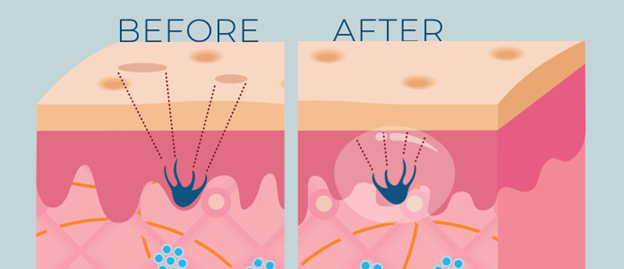
Clinical studies with AstaReal® astaxanthin support the following suggested structure and function claims for skin:
- Tominaga et al. 2009 examined the effect of a combined oral and topical application of astaxanthin on age spots and freckles. Twenty-nine healthy women (ages 20–55) supplemented with 6 mg per day oral AstaReal® astaxanthin and 0.94 mg per day topical AstaReal® astaxanthin for eight weeks. Five independent female evaluators assessed the state of age spots and freckles before and after the trial, rated on a five-grade scale. The evaluators found that age spots and freckles improved or greatly improved in 59% of the study participants. It was found that the area of age spots and freckles was reduced on average by 2.5 mm² after the eight-week supplementation period compared to the baseline (p<0.01).
- Tominaga et al. 2012 also described the lightening of age spots in 29 healthy women (ages 20–55) supplementing with 6 mg per day oral AstaReal® astaxanthin and 0.94 mg per day topical AstaReal® astaxanthin for eight weeks. The area of age spots was reduced by an average of 3 mm² after the eight-week supplementation period compared to the baseline (p<0.01).
- Seki et al. 2001 reported on the effects of astaxanthin cream on the size of 11 healthy women (ages 21–40) applying 0.014 mg per day AstaReal® astaxanthin topical application for three weeks. One subject with a senile pigment macule and two subjects with chloasma (sunburn spots) experienced subjective improvements in skin color.
- In a randomized, double-blind, placebo-controlled, parallel-group comparative study, Tominaga et al. 2017 reported on the anti-inflammatory properties of AstaReal® astaxanthin in the skin of 59 healthy female participants (ages 35–60). Participants supplemented with 12 mg per day (n=19), 6 mg per day (n=22), or 0 mg per day (n=18) AstaReal® astaxanthin softgels from summer to winter, over the course of 16 weeks. Since exposure to seasonal low humidity induces epidermal IL-1α synthesis, levels of this pro-inflammatory marker were measured by ELISA assay after stratum corneum cells were collected from the skin surface using an adhesive skin checker at zero and 16 weeks. Levels of IL-1α at 16 weeks compared to the baseline had increased in both placebo (p<0.01) and 6 mg per day AstaReal® astaxanthin (p<0.05) groups. In contrast, the 12 mg per day AstaReal® astaxanthin group experienced no significant increase in this low-humidity-associated pro-inflammatory cytokine at the stratum corneum. Furthermore, while the placebo group experienced substantial deterioration in skin condition in 16 weeks (p<0.05), as measured by mean depth of the deepest wrinkle, both AstaReal® astaxanthin groups experienced no significant deterioration in skin condition over the same period.
*These are suggested structure and function claims based on AstaReal® studies. These suggested structure and function claims have not been verified for promotional use by a regulatory team. We encourage you to review the studies with your regulatory affairs team to confirm their suitability for promotional applications.
WHY CHOOSE ASTAREAL® ASTAXANTHIN
THE GLOBAL PIONEER: AstaReal, Inc. is the first company in the world to produce natural astaxanthin commercially, and AstaReal® is the only brand backed by over 30 years of research and innovation.BE YOU, JUST HEALTHIER: The AstaReal group has established other initiatives that are in line with their corporate philosophy of making the world healthier with natural astaxanthin. These include community health and wellness programs, a global symposium focusing on natural astaxanthin, and sponsorship grants for groups and individuals.
THE LEADING EXPERT: AstaReal is an expert in natural astaxanthin cultivation, R&D, and clinical science.
THE AUTHORITY IN HUMAN CLINICAL STUDIES: AstaReal® is the only brand of natural astaxanthin backed by over 60 human clinical studies.
UNRIVALED PRODUCT QUALITY: Two state-of-the-art, indoor production sites in the USA and Sweden produce a consistent and stable supply of natural astaxanthin products with unrivaled levels of product quality and purity. AstaReal® is USP, non-GMO, ISO, HACCP, halal, and kosher certified, and it has approved Health Canada claims.
MADE IN THE USA: From cultivation to extraction, AstaReal® astaxanthin is made in the USA to ensure the best quality and traceability. Their proprietary closed, indoor cultivation technique is unique to the industry and the only one of its kind in North America.

Thank you
Thank you for your inquiry and interest in ChemPoint.
We will respond to you shortly.
ChemPoint will not under any circumstances release personal user information to individuals or companies. All information collection is solely used to support ChemPoint customers service communications. Read our Privacy Notice.
Are you in the correct region?
We’ve detected that you are located in a different region than the region selected on the website. Would you like to change your region?
Current Region: English - Canada